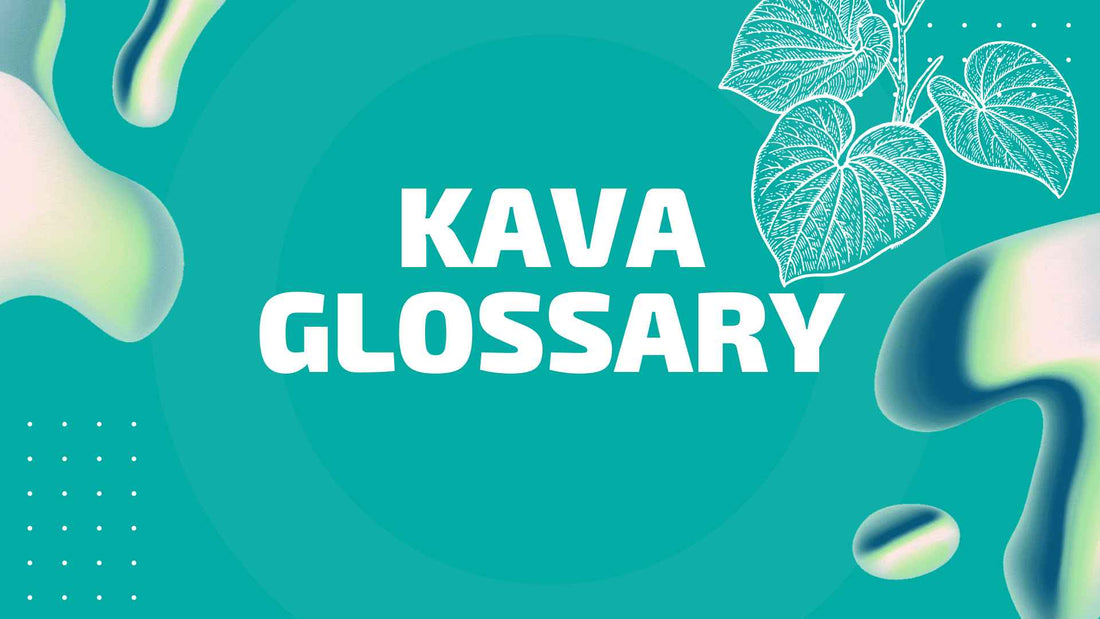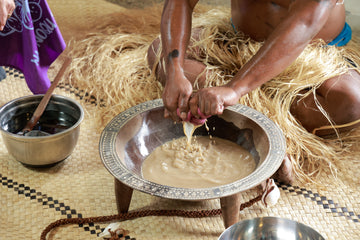Kava Glossary and Key Terms

Bula! Embark on a journey through the Pacific Islands with this handy kava glossary. As you navigate the seas of kava culture and traditions, this guide will be a useful resource to refer to from time to time. It's more than just a plant; it's a tradition, a way of life, and a key to understanding the Pacific spirit. Enjoy your journey!
Kava Varieties

Kava comes in various strains and grades, each offering unique effects. This category lists several of these strains.
Borogu. Originating from Vanuatu, Borogu is typically classified as a Noble kava, known for its balanced effects. Noble kavas are favoured for daily consumption due to their pleasant effects and minimal side effects.
Borongoru. Also from Vanuatu, Borongoru is a Noble kava revered for its heavy, sedative effects. Like other Noble varieties, it's widely accepted for regular use.
Dried Kava. Kava root that has been dried after harvesting, usually for preservation and easier transportation.
Feral Kava. This is essentially cultivated kava that, over time, reverts to a wild state. Its classification can vary, but its roots are typically in Noble strains.
Lewena. Refers to the kava plant's stump. While Lawena itself isn't a classification of kava's effects, it's often associated with Noble varieties when it comes to its quality.
Noble Kava. A broad classification for kava strains associated with a pleasant experience. Noble kavas are the most commonly consumed varieties.
Pouni Ono. Known for its uplifting effects, Pouni Ono often originates from Tonga and is classified under the Noble kavas.
Tudei Kava (Two-day Kava). This kava strain has a strong effect and potential next-day "hangover." It's less frequently used than Noble varieties and isn't recommended for regular consumption.
Waka. This term refers to the lateral roots of the kava plant and is known for its potency. Waka itself isn't a classification of kava's effects, but when harvested from Noble strains, it maintains the Noble classification.
Wild Kava. Kava that grows naturally without cultivation. Like Feral Kava, its classification can vary, but many Wild Kavas originate from Noble strains.
Kava Product Types
Explore the diverse range of kava product types that offer convenience and accessibility to enthusiasts. This category highlights various forms of kava for consumption.
Acetonic Extract. Kava extract obtained using acetone as a solvent.
Aqueous Extract (or Water Extract). Kava extract derived using water, closely resembling traditional preparations.
Ethanolic Extract. Kava extract obtained using ethanol as a solvent.
Kava Capsules. Kava in pill form, usually for ease of consumption.
Kava Concentrate. A concentrated liquid form of kava, made by extracting the kavalactones from the kava root.
Kava Shots. Small, single-serving bottles of concentrated kava liquid, usually flavoured and sweetened.
Kava Steep Tea. A tea made by steeping kava root powder in hot water.
Kava Tincture. A liquid extract of kava, usually made by soaking the kava root in alcohol to extract the kavalactones.
Micronized Kava. Finely ground kava that can be mixed directly with water, without needing straining.
Waka. The lateral roots of the kava plant, which usually contain a higher concentration of kavalactones compared to other parts of the plant.
Dive deep into the world of kava with our comprehensive range of products. Whether you're new to kava or a seasoned enthusiast, we've got something for everyone. From traditional powders to instant options and specially formulated capsules and tablets designed to enhance sleep, focus, and more, our selection caters to every kava lover's needs.
Kava Culture & Tradition

The cultural significance of kava spans multiple Pacific societies. The list below covers aspects of kava-related traditions and ceremonies.
Bilo (Kava bowl). A vessel for serving kava.
Bula. A Fijian term of greeting, also associated with kava culture.
Kava Ceremony. Traditional event in which kava is prepared and consumed, fostering communal ties.
Kava Dance. Traditional dance performed during kava ceremonies.
Kavatime (time to drink Kava). Designated moments when kava is traditionally consumed.
Malo (traditional attire). Garment worn during kava ceremonies.
Nakamal. A traditional meeting place or area where kava is prepared and consumed in many Pacific Island communities.
Sevusevu (traditional offering). Offering given, usually kava, as a gesture of respect or to seek permission.
Tanoa. A large wooden bowl used in the preparation and presentation of kava.
Kava Effects
Different strains of kava can lead to varying effects, largely due to the specific kavalactones they contain. This section describes terms related to these effects.
Balanced Kava. Refers to kava effects that are neither too heady nor too heavy.
Heady Kava. Kava effects that are more cerebral and uplifting.
Heavy Kava. Kava effects that are more sedating and body-oriented.
Sakau. Pohnpeian term for both the plant and the effects of its drink.
Yagona. Fijian term referring to the kava drink and its effects.
Kava Chemistry & Composition
Kava's effects come from its unique chemical makeup. This section breaks down the primary compounds found in kava and their significance.
Chemotype. The chemical profile of a plant, including the types and ratios of compounds it contains. Kava varieties are often classified by their chemotype.
Desmethoxyyangonin. One of the six main kavalactones with potential euphoric effects.
Dihydrokavain. One of the six primary kavalactones known for its sedative properties.
Dihydromethysticin. A kavalactone that may have sedative and analgesic effects.
Flavokawains. A group of chalcones found in kava, currently being researched for their biological activities.
GABA. Gamma-aminobutyric acid, a neurotransmitter that inhibits the activity of nerve cells in the brain. Kava is thought to affect GABA receptors, which may explain some of its calming effects.
High-Performance Liquid Chromatography (HPLC). A technique used in analytical chemistry to separate, identify, and quantify each component in a mixture.
Kavain. A prominent kavalactone often associated with kava’s euphoric effects.
Kavalactones. A class of lactone compounds primarily responsible for the effects of kava.
Methysticin. A major kavalactone that might contribute to mood-enhancing effects.
Yangonin. One of the six principal kavalactones with potential psychoactive effects.
Kava Preparation

Preparing kava is an art, blending tradition with innovation. This list covers various tools and methods used in kava preparation.
AluBall (modern Kava-making tool). A device for quickly and easily preparing kava.
Bilo. A traditional cup made from a coconut shell used for drinking kava in many Pacific Island cultures.
Dried Kava. Kava root that has been dried for preservation and later use.
Fresh Green Kava. Kava root in its natural, freshly-harvested state.
Grog. A common term used in the Pacific Islands for a drink made from kava root powder mixed with water.
Kneading. The manual process of extracting kava by massaging the root or powder in water.
Kosa (or Makas). The hard, fibrous part of the kava root, typically discarded during preparation due to its low kavalactone content.
Micronized Kava. Finely ground kava that can be mixed directly with water, without needing straining. Also called Instant Kava.
Straining. The process of separating the liquid kava drink from the root material.
Toss & Wash. A method of consuming kava by placing a portion of kava powder in the mouth, and then washing it down with a liquid.
Tanoa. Traditional wooden vessel for preparing kava.
Traditional Preparation. The customary method of preparing kava, often involving kneading and straining.
Waka. The lateral roots of the kava plant, which usually contain a higher concentration of kavalactones compared to other parts of the plant.
Kava Safety, Health & Regulations
With kava's increasing popularity, understanding its safety, potential health effects, and relevant regulations is essential.
Hepatotoxicity. This term refers to the potential toxic effect of kava on the liver. It is a topic of controversy as traditionally prepared kava has a long history of safe use. Many cases of hepatotoxicity may be linked to the use of poor-quality kava, contamination, or the concurrent use of other hepatotoxic substances. At FijiKava, we only use Noble kava varieties, which are associated with a long history of safe use and minimal side effects.
Kava Dermopathy (Kani Kani). This is a reversible skin condition characterized by scaly patches, often associated with heavy kava consumption. Consuming high-quality Noble kava varieties, like those used by FijiKava, can minimize the risk of developing this condition.
Reverse Tolerance. This phenomenon occurs when a person needs to consume kava several times before experiencing its full effects. It is common among new kava users and is not associated with any adverse health effects.
FDA Guidelines. The U.S. Food and Drug Administration (FDA) has issued guidelines and recommendations regarding the use of kava. FijiKava is committed to adhering to all FDA guidelines and regulations to ensure the safety and quality of our products.
Bula vinaka! As this stage of your journey through the world of kava comes to a close, we hope this glossary has been a valuable companion. Remember, the world of kava is as vast and deep as the Pacific Ocean itself, and there is always more to learn and explore.
We hope you will continue to refer to this resource as you delve deeper into the wonderful world of kava. If you think we missed anything or have any questions, please do not hesitate to let us know.
Moce mada and stay kava strong!
Now that you are well-versed in the language of kava, why not explore FijiKava’s range of premium kava products? Click below to discover the best that the Pacific Islands have to offer.


